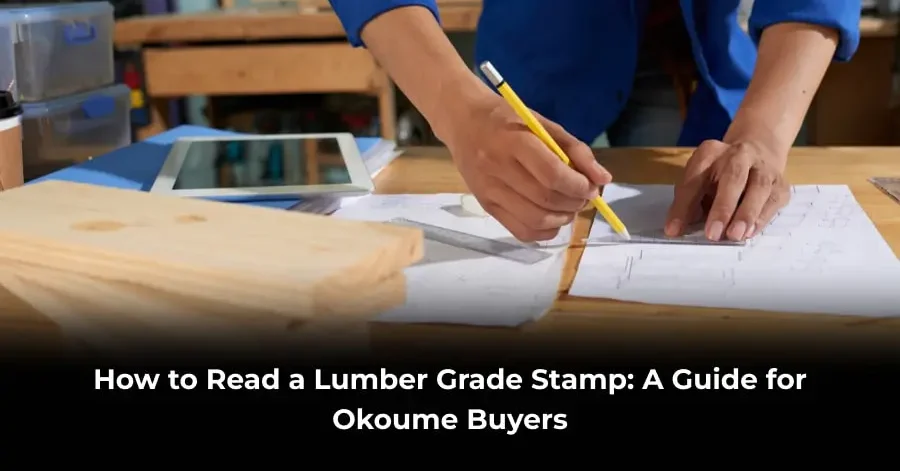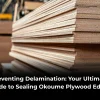Welcome, fellow woodworkers, boat builders, and craftsmen! There’s a unique sense of anticipation that fills the air when you walk into a well-stocked woodworking supplies store. The aroma of fresh sawdust, the feel of raw material under your fingertips, the endless possibilities held within each board—it’s a special kind of excitement. Whether you’re a seasoned pro meticulously selecting materials for a client’s dream project or a passionate hobbyist embarking on a new adventure in your workshop, you’re met with a forest of choices. Among the most beautiful and sought-after species is the elegant Okoume. But with beauty comes the need for understanding. How do you ensure the okoume timber you’re investing in is of the quality your project demands? How can you be sure you’re getting the real thing?
The answer lies in a small, often-overlooked imprint: the lumber grade stamp. This tiny stamp is the wood’s passport, its resume, and its quality guarantee all rolled into one. It’s the industry’s way of speaking to you, telling you the board’s story from forest to rack. Learning to read it is like learning a secret language that empowers you to make confident, informed purchases, transforming a daunting task into a rewarding part of the creative process. This guide will demystify the wood grading system, making you an expert in selecting the perfect piece of okoume timber for your next masterpiece.
Why Bother? The Profound Importance of the Grade Stamp
Before we dive into the specifics, let’s talk about why this matters on a practical level. You wouldn’t buy a car without knowing its mileage and service history, right? You’d want that transparency to ensure your investment is sound. Similarly, the grade stamp tells you the “history” and inherent potential of a board. It provides unbiased, standardized information about the wood’s structural integrity, appearance, and allowable defects. This isn’t just bureaucratic red tape; it’s a universal system designed to protect you, the buyer. For a material like Okoume, prized for its use in marine plywood, furniture, and fine veneers, understanding this stamp ensures:
- You Get Exactly What You Pay For: Higher grades cost more for a very clear reason. The stamp is your safeguard, preventing you from accidentally paying a premium price for a lower-quality board. It levels the playing field between you and the supplier.
- Perfect Project Suitability: A board graded for a hidden structural component in boat building might be entirely wrong for a visible, sleek furniture panel. The stamp instantly tells you if the wood matches your vision, saving you from costly project failures or disappointing results.
- Dramatic Waste Reduction: By understanding the grade, you can accurately estimate how much clear, usable wood you’ll actually get from a board. This allows for precise planning, minimizes off-cuts, and makes your entire operation more efficient and sustainable. It turns guessing into calculating.
Meet the Supermodel of Hardwoods: A Quick Intro to Okoume
Let’s take a moment to appreciate the star of the show. Okoume (pronounced oh-koo-may) is an African hardwood known for its stunning pinkish to pale red hue and a grain that is typically straight but can be interlocked, creating beautiful, wavy patterns that catch the light. It’s relatively lightweight—a joy to work with using both hand and machine tools—and it finishes to a supremely smooth, almost silky surface. Its most famous application is as the primary veneer in marine-grade plywood, beloved by boat builders for its stability and resistance to checking. But its appeal doesn’t stop at the dock; it’s also a favorite for high-end cabinetry, decorative millwork, and even musical instruments for its acoustic properties. Because it’s almost exclusively imported from West-Central Africa, buying professionally graded okoume timber is not just a suggestion; it’s crucial to ensure consistency, quality, and that you’re actually receiving the species you ordered. This is where that trusty stamp becomes your first line of defense.
Breaking Down the Lumber Grade Stamp: A Step-by-Step Analysis
A typical grade stamp is a rectangular mark containing several key pieces of information. While the exact layout can vary slightly by grading agency, the core elements remain consistent. Let’s dissect them one by one. (We’ll use some example wood grade images in our descriptions to help you visualize). Think of yourself as a detective, and this stamp is your case file.
- The Grading Agency or Mill Number: The “Who Can You Trust?” Mark
This is the official body that certified the wood’s quality. Think of them as the underwriters or the top-tier referees of the wood world. Their presence on the stamp means the lumber has been inspected according to strict, recognized rules. Common agencies include:
- NLGA: National Lumber Grades Authority (Canada’s primary agency)
- ALSC: American Lumber Standard Committee (Provides oversight for the U.S. system)
- SPIB: Southern Pine Inspection Bureau
- WWPA: Western Wood Products Association
Sometimes, you might just see a mill’s registration number. This isn’t a red flag! This number is traceable back to the ALSC and holds the mill accountable to the grading rules. It signifies the mill has a certified lumber grader on staff.
- The Species of Wood: The “What Is It?” Check
This is a straightforward but critical identifier. It names the tree species. For our purposes, you’ll be looking for “OKOUME” or sometimes its botanical name, Aucoumea klaineana. This is your first and most important check to ensure you’re actually getting the beautiful, workable Okoume you asked for from your woodworking supplies store and not a less expensive look-alike. It confirms the fundamental nature of the material you’re about to use. - The Grade Itself: The “How Good Is It?” Heart of the Matter
This is the absolute core of the stamp! The grade is a shorthand code that summarizes the quality of the board based on the complex wood grading system. The rules themselves are detailed, but the grade gives you the powerful bottom line. For hardwoods like Okoume, the most common system is from the NHLA (National Hardwood Lumber Association). Key grades you’ll encounter include:
- FAS (First and Seconds): The highest grade. It has strict minimum board size requirements (8′ x 6″ wide) and must yield at least 83.3% clear face cuttings. This is the go-to for high-end furniture, architectural woodworking, and long, clear moldings where appearance is paramount.
- Select: Very similar to FAS in quality but allows for slightly smaller board sizes. It’s a great option when you need large clear areas but your project components are a bit shorter.
- #1 Common: Often called “Cabinet Grade.” It yields about 66.7% clear face cuttings. This grade is perfect for kitchen cabinets, furniture parts, and millwork where you can cut around more knots and defects to yield shorter clear pieces. It offers fantastic value.
- #2 Common: Known as “Economy Grade.” It yields about 50% clear cuttings. This is great for flooring, utility furniture, or rustic projects where character, knots, and natural defects are part of the desired aesthetic and not a drawback.
- The Moisture Content: The “Is It Ready?” Status Update
This indicates whether the wood was graded while green (un-dried) or dried. This is a huge factor in the wood’s stability and suitability for indoor projects. Key designations:
- S-GRN: Surface Green. This means it has a very high moisture content. It will shrink significantly as it dries and is generally not suitable for fine woodworking until it has been properly seasoned.
- S-DRY: Surface Dry. Moisture content of 19% or less. This is common for construction lumber and some outdoor applications.
- MC15: Moisture Content 15%. This is a very common target for furniture-grade wood in most home environments, offering a good balance of stability and workability.
- KD or KD-HT: Kiln Dried or Kiln Dried-Heat Treated. This is the gold standard for fine woodworking and international shipping. Kiln-drying ensures stability, minimizes future movement and warping, and HT (heat treatment) is a phytosanitary requirement for export to kill any insects or pests. For okoume timber, which is imported, KD-HT is almost a given and what you should look for.
- The Certification Mark: The “Seal of Approval”
This is often a checkmark, a shield, or the words “Certified Grade” that indicate the mill’s grading was supervised, audited, and approved by the central agency. It’s the final seal of authenticity on the entire stamp.
Also Read: Why the NHLA Hardwood Grading System is Crucial for Quality Okoume Lumber
Applying This to Real Life: Reading an Okoume Stamp
Let’s imagine a stamp on a beautiful board of okoume timber:
[NLGA] [OKOUME] [FAS] [KD-HT] [15]
Now, let’s read its story:
- NLGA: This board was graded under the rigorous Canadian rules by the National Lumber Grades Authority.
- OKOUME: It’s confirmed, genuine Okoume—no substitutes.
- FAS: This is the highest quality grade, promising large, clear cuttings with minimal defects. It’s the top shelf option.
- KD-HT: It has been Kiln Dried and Heat Treated. It’s stable, ready for precise work, and has been certified for international shipment.
- 15: Its moisture content is at 15%, making it ideally suited for interior furniture projects in most climates.
This single line of text tells you you’re holding a top-tier, stable, and ready-to-use board perfect for a high-visibility, precision project. It justifies its price tag with certified quality.
Visual Learning: The Power of Wood Grade Images
While text is informative, nothing beats seeing it in practice. We highly recommend searching for “hardwood lumber grade stamp examples” or “wood grade images” online. Many grading agencies provide fantastic visual guides and PDF booklets that show real-world stamps from different angles. When you’re at your local woodworking supplies store, don’t be shy! Ask the knowledgeable staff to point out the stamps on different grades of okoume timber. A good supplier will be happy to educate a curious customer. Seeing the tangible difference between a flawless FAS board and a character-filled #1 Common board side-by-side is the best education you can get. It bridges the gap between theory and practice.
Where to Find Quality Graded Okoume: A Word on AEW Woods
Once you understand the language of grading, your next step is finding a supplier that values transparency and quality as much as you do. This is where partnering with a reputable specialist makes all the difference. You can have all the knowledge in the world, but it must be paired with a source of truly great wood.
For discerning woodworkers across the UK and Europe, AEW Woods has established itself as a premier provider of high-quality, sustainably sourced timber, including exquisite okoume timber. What sets a supplier like AEW Woods apart is their deep expertise and commitment to customer education. They don’t just sell wood; they provide the knowledge and support that goes with it. Their team genuinely understands the intricacies of the wood grading system and can guide you to the right grade of Okoume for your specific application, whether it’s for precision marine plywood, elegant veneers, or solid wood project parts. They take the guesswork out of sourcing. By choosing a specialized woodworking supplies store like AEW Woods, you ensure that the grade stamp on your lumber is backed by expert service, ethical sourcing practices, and a genuine guarantee of quality, making your entire project journey smoother and more successful from start to finish.
Conclusion
Learning to read a lumber grade stamp is a fundamental skill that transforms you from a passive buyer into an empowered, confident artisan. That small, inky imprint on a board of okoume timber is a powerful tool, unlocking a wealth of vital information about its strength, beauty, and potential. By understanding the components of the stamp—the agency, the species, the grade, and the moisture content—you can navigate any woodworking supplies store with a keen eye and the assurance that you are in control of your choices.
You can now decipher the complex wood grading system, use wood grade images for reference, and make intelligent choices that ensure the success of your projects and the efficient use of your budget. This knowledge allows you to have informed, productive conversations with suppliers and ultimately select the perfect material for bringing your creative visions to life. So, the next time you’re admiring the beautiful pink hue of a stack of Okoume, take a moment to look for its stamp. It has a detailed story to tell, and you now know how to listen. Happy building
Frequently Asked Questions (FAQs)
Q1: Is a higher grade always better?
A: Not necessarily. “Better” is entirely dependent on your project and budget. While FAS is the highest quality, it’s also the most expensive. For small cabinet parts, drawer sides, or projects where knots and sapwood add character and a rustic feel, #1 or #2 Common can be more economical and equally—if not more—suitable. The grade ensures you get the appropriate quality for the price you pay.
Q2: Can the grade stamp be sanded off or planed away?
A: Yes, it can be. The stamp is applied with ink on the surface. If you plane or sand the face of the board, you will remove it. It’s a good practice to mark the grade on the end of the board with a pencil for your own reference after you’ve milled it, especially if you’re working with multiple grades at once.
Q3: Does the wood grading system account for color?
A: For most standard hardwood rules (like NHLA), the grade is primarily based on the size and number of clear defect-free cuttings, not color variation. Color is generally considered a natural characteristic of the wood, not a defect. However, some specific rules for certain species or higher-tier “select” grades from specific mills may have additional color requirements to ensure a more uniform appearance.
Q4: Why is some Okoume sold without a visible stamp?
A: This is very common with pre-planed or “S4S” (surfaced on four sides) lumber, as the planing process removes the surface where the stamp was applied. It may also be sold in smaller, broken-down bundles from a larger, graded unit. This is why it’s critical to always buy from a reputable woodworking supplies store that can verify the grade of their inventory and provide trustworthy information.
Q5: How does grading for Okoume plywood differ from solid wood?
A: Plywood grading is a completely different system. It typically involves a two-letter grade (e.g., “A-A,” “A-B”) that describes the quality of the face and back veneers. The core construction (e.g., marine-grade with waterproof glue) is also a critical factor separate from the face grade. A stamp on marine plywood will also indicate its certification standard (e.g., BS1088 for marine use).






